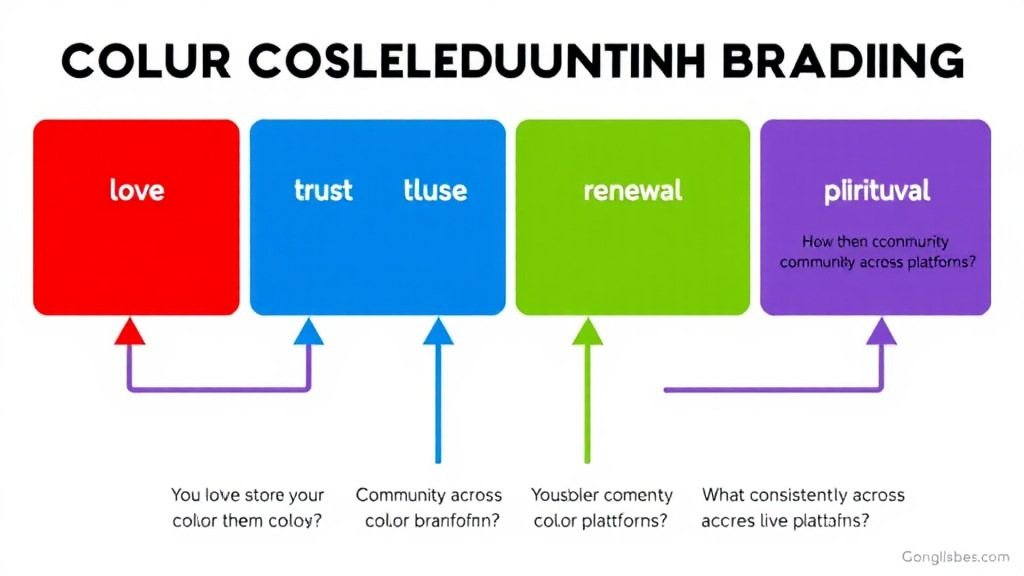Choosing a color scheme that reflects your faith and mission as a church can significantly influence the perception and emotional connection of your community. Understanding color psychology, cultural context, and denominational beliefs can guide the selection of hues that enhance your church branding while fostering a welcoming atmosphere.
Key Takeaways
- Understanding Color Psychology: Color choices should reflect the identity and mission of the church, taking cultural and denominational nuances into account.
- Emotional and Symbolic Significance: Colors evoke different emotions (e.g., blue for tranquility, red for passion) and can carry subconscious messages that influence the perception of your church.
- Avoiding Common Mistakes: Be mindful of poor color choices that may lead to negative perceptions or confusion about your church’s identity.
- Practical Steps for Selection: Engage your congregation, research cultural significance, and maintain consistency across all branding elements to enhance recognition and clarity.
If you seek guidance on automating your church’s branding efforts, get started with ipsom.io.
The Importance of Color Schemes in Church Branding
Choosing the right color scheme for your church branding is not just an aesthetic choice; it plays a vital role in shaping community perceptions. Colors have psychological impacts, influencing how people feel and connect with your church. By understanding color psychology, you can select hues that reflect your church's mission and create an inviting atmosphere.
Color Psychology in Cultural Context
Different cultures assign varied meanings to colors. For example, red can symbolize love in some cultures but may signify danger in others. Therefore, understanding cultural nuances is crucial when selecting colors. Additionally, different denominations may have varying traditions associated with certain colors. For instance, purple often represents spirituality in many Christian contexts. Research local implications to avoid misinterpretations, ensuring your color choices resonate positively with your community.
Emotional Impact of Colors
Colors elicit strong emotions that can enhance the atmosphere of your church. For example, blue is associated with tranquility, offering a calming environment perfect for worship. On the other hand, green symbolizes renewal, making it suitable for themes of growth and rejuvenation. By consciously selecting colors that evoke desired feelings, you can effectively foster an emotional connection with your congregation. For instance, a thoughtful mix of colors can transform the vibe of your worship space into one that encourages peace, joy, or spiritual uplift.
Choosing a Color Scheme That Reflects Your Mission
Selecting a color scheme that embodies your church's mission and identity is vital for effective branding. It sets the tone for your community and communicates your values at a glance. Begin by understanding your church’s core message and how colors can enhance this narrative.
Steps for Effective Color Selection
Start with a deep dive into your church identity. Colors should resonate with your mission, values, and message. Following that, engage your congregation and gather their insights on color preferences. This collaborative approach strengthens community bonds and ensures that chosen colors reflect collective sentiments. Moreover, analyze your community's demographics and cultural backgrounds, recognizing that perceptions of color can vary significantly across different groups.
Practical Considerations
When selecting colors, it's important to test combinations. Create mock-ups of potential color schemes to visualize how they interact within your branding context. Simplifying selections by adopting a dominant color can streamline the palette, making it easier to create cohesion. Consistency is critical across all branding elements, including your website, logos, and printed materials. This uniformity aids in reinforcing your church's identity and message clearly.
Common Color Mistakes to Avoid
When selecting a color scheme for your church, some common mistakes can lead to misalignment with your mission. One significant mistake is using bright colors solely for attention without considering their emotional resonance. Colors should represent more than just visual appeal; they must convey the values and mission of the church. Avoid the trap of simply choosing trendy colors or favorites without understanding their meanings and implications.
Another frequent error is imposing competitors’ color schemes. While being inspired by others is natural, your church should aim for a unique palette that enhances brand recognition. Imitation may confuse your congregation about your identity. Also, using vague colors that fail to evoke specific emotions can leave visitors feeling indifferent about your church. Strive for uniqueness to create a genuine connection.
Understanding Color Theory
An understanding of color theory is essential for effective branding. Familiarize yourself with color classifications, such as primary, secondary, and tertiary colors. Each category serves a purpose and can influence branding effectiveness. For example, primary colors are often perceived as bold and energetic, while pastels may feel softer and more calming.
Exploring various color combinations like monochromatic, complementary, and analogous schemes can enhance the visual appeal of your branding. A monochromatic scheme uses varying shades of a single color, creating cohesion. In contrast, complementary colors, which sit opposite each other on the color wheel, can create dynamic contrasts that energize your branding. Leveraging these strategies helps ensure that your church’s colors resonate well with your mission and community.
The Heart of Color Selection: Symbolism and Emotion
Biblical Meanings of Colors
Incorporating scripture into design can lead to profound connections. Each color carries symbolic meanings that resonate with biblical references. For instance, blue often represents the Word of God, embodying trust and fidelity. Purple, linked to royalty, signifies dignity and spiritual authority. Selecting colors that exemplify your church's values fosters a deeper connection and understanding among your community. By aligning your color choices with these significant biblical meanings, you enhance your church's identity.
The Power of First Impressions
Color choices play a pivotal role in shaping first perceptions. From the moment visitors approach your church, colors can influence their initial experiences and establish an emotional foundation. Warm, inviting colors can evoke feelings of welcome, while cooler tones may convey professionalism and serenity. Creating emotional connections is essential, as colors are powerful design elements that can evoke strong feelings. A well-thought-out color scheme not only attracts newcomers but also encourages long-term involvement from the congregation.
Creating a Welcoming Atmosphere Through Color
Colors play a crucial role in creating a welcoming atmosphere in any church setting. The right color choices can influence feelings of comfort, peace, and connection within your community. By selecting colors that are not only visually appealing but also emotionally resonant, your church can foster a sense of belonging and spirituality among attendees.
Suggested Colors for Worship Spaces
White is an excellent choice for worship spaces as it brightens the area and enhances the visibility of symbols or decor. It promotes feelings of purity and cleansing, making it an ideal background for worship experiences. In contrast, beige serves as a neutral backdrop that allows other colors to stand out without overpowering the space. It creates a soft and inviting atmosphere.
Purple is often associated with spirituality, making it calming and enriching for congregations during worship. It symbolizes both royalty and humility, resonating deeply with many church messages. Additionally, dark green encourages focus, reflecting a connection with nature and growth in faith. Lastly, grey can provide a calming neutral tone that inspires contemplation, fostering a peaceful environment for reflection.
Color Schemes in Various Contexts
The application of color schemes should extend to your church's website design. Colors should be visually accessible and convey the core values of the church. A well-designed color scheme can enhance user experience while inviting potential visitors to explore more about your community.
In terms of the church building aesthetics, paint colors should align with the art and traditional features within the building, such as stained glass. Consistency in color choices across all aspects of the church not only reinforces branding but also enhances the overall experience for congregants and visitors.
Utilizing Feedback and Consistency
Gathering input from your congregation is essential in the color selection process. Encouraging participation allows community members to express their feelings about specific colors and how they connect with the church's mission. Organizing discussions, surveys, or workshops can help capture diverse opinions and ensure that the final choices resonate with your congregation.
Ensuring visual accessibility is another crucial aspect of feedback. Some color combinations may be difficult for individuals with visual impairments to distinguish. Testing colors for readability across various media, such as websites and printed materials, can enhance inclusivity and ensure effective communication.
Ongoing Adjustments
The process of color selection is not static; it should be iterative. As your church evolves and demographics shift, it’s important to remain open to revisiting your color choices. Conduct regular reviews to assess whether the selected colors still align with the church's mission and member preferences.
Striving for a unified message is vital. The overarching color scheme should consistently reflect the church’s values and mission across all platforms. By maintaining a cohesive color identity, you strengthen community ties and enhance recognition, fostering a sense of unity and purpose among attendees.
FAQ
Why is color selection important for my church's branding?
Color selection is vital for branding as it conveys your church's identity and mission. A well-chosen color scheme can evoke specific emotions, improving community connection and attracting new visitors. It can also help establish a unique visual identity, differentiating your church from others.
How do I understand the cultural significance of colors within my community?
Understanding cultural significance involves researching the meanings associated with colors in your specific demographic. Engage with community members to gather insights about color perceptions and their emotional impacts. Analyzing local customs and traditions will also help ensure your color choices resonate well.
What are common emotional responses associated with different colors?
Different colors can evoke distinct emotions. For instance, red often symbolizes love and passion, while blue represents trust and tranquility. Green is associated with nature and renewal, while purple conveys spirituality and royalty. Aligning these associations with your church's mission can enhance emotional connections.
How can I involve my congregation in the color selection process?
Involving your congregation can be done through open discussions or surveys. Gather feedback on color preferences and emotional responses to specific colors. This inclusive approach not only fosters community engagement but also ensures that your branding aligns with the values of your church members.
What are some practical steps for testing color combinations?
Start by creating mock-ups to visualize different combinations in contexts relevant to your church. Use tools like color palette generators or design software to see how colors interact in layouts. Additionally, solicit feedback from your congregation to ensure the combinations resonate well.
What mistakes should I avoid when choosing a color scheme for my church?
Avoid using colors solely for attention without considering their meaning. Selecting personal favorites can lead to misalignment with your church's mission. Also, refrain from imitating competitors; strive for originality to enhance your brand recognition and community identity.
How does color affect first impressions of my church?
Color significantly shapes initial impressions by influencing emotions and perceptions. A well-thought-out color scheme can create a welcoming atmosphere, encouraging visitors to engage further with your church. Conversely, clashing colors or poor choices may create confusion, negatively impacting their experience.
Are there biblical guidelines for specific colors to use in church branding?
Colors like blue and purple have biblical significance, often associated with themes such as spirituality and royalty. Incorporating these colors into your branding can communicate your church's values and mission, reinforcing your connection to scripture.
How important is consistency in my church's color scheme across various platforms?
Consistency in your color scheme across platforms is crucial for brand recognition. A unified color palette creates a cohesive visual identity, making your church easily identifiable in digital and physical spaces. Consistency fosters trust and clarity within the community.
How can I maintain an open dialogue with my congregation regarding color perceptions?
Encourage ongoing feedback on color choices and perceptions through discussion forums, surveys, or suggestion boxes. Regularly engage with your congregation about the significance of color and invite them to share their thoughts on potential changes or new ideas to foster inclusivity and openness.






